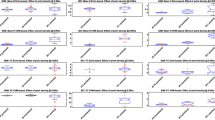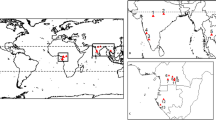Abstract
The new-era space-borne LiDAR systems, viz. ICESat-2 and GEDI, offer new possibilities for mapping terrain and canopy heights through geophysical data products, viz ATL08 (ICESat-2) and L2A (GEDI). Additionally, GEDI provides an above-ground biomass density (AGBD) product (L4A) derived through parametric calibration of L2A metrics. Detailed comparisons of these data products among different forest types and other influencing factors (viz. acquisition parameters and ground conditions) are essential for continued improvement and broader use. In this study, we perform a detailed accuracy assessment of these data products over tropical dry deciduous forests in the Central Indian region during leaf-off and leaf-on seasons with the reference airborne LiDAR data. The GEDI L4A (AGBD) product is validated against the reference AGBD map derived from the field AGBD estimates and canopy height model from airborne LiDAR. Our results suggest that regardless of leaf condition, strong or power beams during nights from both systems (GEDI and ICESat-2) are highly capable of retrieving terrain height with RMSE 2.8–3.8 m and low bias of − 0.2 m to + 1.4 m. Nevertheless, GEDI canopy height retrievals were strongly linked to leaf availability with significant underestimations (bias > − 5.8 m) during the leaf-off season against a bias of ± 1 m during the leaf-on season. In contrast, strong night beams from ICESat-2 were found to retrieve canopy heights accurately with a bias of − 0.4 m and RMSE of 3.5 m during the leaf-off season. The GEDI-AGBD estimates were found to be substantially mismatched with the reference AGBD map with an overall RMSE of 46%. The atmospheric conditions and topographic slope strongly influenced the accuracy of both systems.







Similar content being viewed by others
Data Availability Statement
The GEDI and ATLAS data used in this study are open-source datasets and can be downloaded from https://search.earthdata.nasa.gov/. The field measurements and LiDAR measurements are available with the corresponding author (Suraj Reddy Rodda). The data are not publicly available due to the restrictions and policies made during data collection.
References
Adam, M., Urbazaev, M., Dubois, C., & Schmullius, C. (2020). Accuracy assessment of GEDI terrain elevation and canopy height estimates in European temperate forests: Influence of environmental and acquisition parameters. Remote Sensing, 12(23), 3948. https://doi.org/10.3390/rs12233948.
Baskerville, G. L. (1972). Use of logarithmic regression in the estimation of plant biomass. Canadian Journal of Forest Research, 2(1), 49–53. https://doi.org/10.1139/x72-009.
Chave, J., Réjou-Méchain, M., Búrquez, A., Chidumayo, E., Colgan, M. S., Delitti, W. B. C., Duque, A., Eid, T., Fearnside, P. M., Goodman, R. C., & Henry, M. (2014). Improved allometric models to estimate the aboveground biomass of tropical trees. Global Change Biology, 20(10), 3177–3190. https://doi.org/10.1111/gcb.12629.
Coops, N. C., Tompalski, P., Goodbody, T. R. H., Queinnec, M., Luther, J. E., Bolton, D. K., White, J. C., Wulder, M. A., van Lier, O. R., & Hermosilla, T. (2021). Modelling lidar-derived estimates of forest attributes over space and time: A review of approaches and future trends. Remote Sensing of Environment, 260, 112477. https://doi.org/10.1016/j.rse.2021.112477.
Dorado-Roda, I., Pascual, A., Godinho, S., Silva, C. A., Botequim, B., Rodríguez-Gonzálvez, P., González-Ferreiro, E., & Guerra-Hernández, J. (2021). Assessing the accuracy of GEDI data for canopy height and aboveground biomass estimates in Mediterranean forests. Remote Sensing, 13(12), 2279. https://doi.org/10.3390/rs13122279.
Dubayah, R., Blair, J. B., Goetz, S., Fatoyinbo, L., Hansen, M., Healey, S., Hofton, M., Hurtt, G., Kellner, J., Luthcke, S., & Armston, J. (2020). The Global Ecosystem Dynamics Investigation: High-resolution laser ranging of the Earth’s forests and topography. Science of Remote Sensing, 1, 100002. https://doi.org/10.1016/j.srs.2020.100002.
Duncanson, L., Kellner, J. R., Armston, J., Dubayah, R., Minor, D. M., Hancock, S., Healey, S. P., Patterson, P. L., Saarela, S., Marselis, S., & Silva, C. E. (2022). Aboveground biomass density models for NASA’s Global Ecosystem Dynamics Investigation (GEDI) lidar mission. Remote Sensing of Environment, 270, 112845. https://doi.org/10.1016/j.rse.2021.112845.
Duncanson, L., Neuenschwander, A., Hancock, S., Thomas, N., Fatoyinbo, T., Simard, M., Silva, C. A., Armston, J., Luthcke, S. B., Hofton, M., & Kellner, J. R. (2020). Biomass estimation from simulated GEDI, ICESat-2 and NISAR across environmental gradients in Sonoma County, California. Remote Sensing of Environment, 242, 111779. https://doi.org/10.1016/j.rse.2020.111779.
Fayad, I., Baghdadi, N., & Lahssini, K. (2022). An assessment of the GEDI Lasers’ capabilities in detecting canopy tops and their penetration in a densely vegetated, tropical area. Remote Sensing, 14(13), 2969. https://doi.org/10.3390/rs14132969.
Fayad, I., Baghdadi, N., & Riédi, J. (2021). Quality assessment of acquired GEDI waveforms: Case study over france, tunisia and french guiana. Remote Sensing, 13(16), 3144. https://doi.org/10.3390/rs13163144.
Fernandez-Diaz, J. C., Velikova, M., & Glennie, C. L. (2022). Validation of ICESat-2 ATL08 terrain and canopy height retrievals in tropical Mesoamerican forests. IEEE Journal of Selected Topics in Applied Earth Observations and Remote Sensing, 15, 2956–2970. https://doi.org/10.1109/JSTARS.2022.3163208.
Ghosh, S. M., Behera, M. D., Kumar, S., Das, P., Prakash, A. J., Bhaskaran, P. K., Roy, P. S., Barik, S. K., Jeganathan, C., Srivastava, P. K., & Behera, S. K. (2022). Predicting the forest canopy height from LiDAR and multi-sensor data using machine learning over India. Remote Sensing, 14(23), 5968. https://doi.org/10.3390/rs14235968.
Khosravipour, A., Skidmore, A. K., & Isenburg, M. (2016). Generating spike-free digital surface models using LiDAR raw point clouds: A new approach for forestry applications. International Journal of Applied Earth Observation and Geoinformation, 52, 104–114. https://doi.org/10.1016/j.jag.2016.06.005.
Khosravipour, A., Skidmore, A. K., Isenburg, M., Wang, T., & Hussin, Y. A. (2014). Generating pit-free canopy height models from airborne lidar. Photogrammetric Engineering & Remote Sensing, 80(9), 863–872. https://doi.org/10.14358/PERS.80.9.863.
Lahssini, K., Baghdadi, N., Le Maire, G., & Fayad, I. (2022). Influence of GEDI acquisition and processing parameters on canopy height estimates over tropical forests. Remote Sensing, 14(24), 6264. https://doi.org/10.3390/rs14246264.
Lefsky, M. A. (2010). A global forest canopy height map from the Moderate Resolution Imaging Spectroradiometer and the Geoscience Laser Altimeter System. Geophysical Research Letters. https://doi.org/10.1029/2010GL043622.
Liu, A., Cheng, X., & Chen, Z. (2021). Performance evaluation of GEDI and ICESat-2 laser altimeter data for terrain and canopy height retrievals. Remote Sensing of Environment, 264, 112571. https://doi.org/10.1016/j.rse.2021.112571.
Musthafa, M., & Singh, G. (2022). Forest above-ground woody biomass estimation using multi-temporal space-borne LiDAR data in a managed forest at Haldwani, India. Advances in Space Research, 69(9), 3245–3257. https://doi.org/10.1016/j.asr.2022.02.002.
Musthafa, M., Singh, G., & Kumar, P. (2023). Comparison of forest stand height interpolation of GEDI and ICESat-2 LiDAR measurements over tropical and sub-tropical forests in India. Environmental Monitoring and Assessment, 195(1), 1–17. https://doi.org/10.1007/s10661-022-10657-w.
Nandy, S., Srinet, R., & Padalia, H. (2021). Mapping forest height and aboveground biomass by integrating ICESat-2, Sentinel-1 and Sentinel-2 data using Random Forest algorithm in northwest Himalayan foothills of India. Geophysical Research Letters, 48(14), e2021GL093799. https://doi.org/10.1029/2021GL093799.
Narine, L. L., Popescu, S. C., & Malambo, L. (2020). Using ICESat-2 to estimate and map forest aboveground biomass: A first example. Remote Sensing, 12(11), 1824. https://doi.org/10.3390/rs12111824.
Neuenschwander, A., Guenther, E., White, J. C., Duncanson, L., & Montesano, P. (2020). Validation of ICESat-2 terrain and canopy heights in boreal forests. Remote Sensing of Environment, 251, 112110. https://doi.org/10.1016/j.rse.2020.112110.
Neuenschwander, A. L., & Magruder, L. A. (2019). Canopy and terrain height retrievals with ICESat-2: A first look. Remote Sensing, 11(14), 1721. https://doi.org/10.3390/rs11141721.
Neuenschwander, A., & Pitts, K. (2019). The ATL08 land and vegetation product for the ICESat-2 Mission. Remote Sensing of Environment, 221, 247–259. https://doi.org/10.1016/j.rse.2018.11.005.
Neumann, T. A., Martino, A. J., Markus, T., Bae, S., Bock, M. R., Brenner, A. C., Brunt, K. M., Cavanaugh, J., Fernandes, S. T., Hancock, D. W., & Harbeck, K. (2019). The Ice, Cloud, and Land Elevation Satellite–2 Mission: A global geolocated photon product derived from the advanced topographic laser altimeter system. Remote Sensing of Environment, 233, 111325. https://doi.org/10.1016/j.rse.2019.111325.
Potapov, P., Li, X., Hernandez-Serna, A., Tyukavina, A., Hansen, M. C., Kommareddy, A., Pickens, A., Turubanova, S., Tang, H., Silva, C. E., & Armston, J. (2021). Mapping global forest canopy height through integration of GEDI and Landsat data. Remote Sensing of Environment, 253, 112165. https://doi.org/10.1016/j.rse.2020.112165.
Réjou-Méchain, M., Barbier, N., Couteron, P., Ploton, P., Vincent, G., Herold, M., Mermoz, S., Saatchi, S., Chave, J., De Boissieu, F., & Féret, J. B. (2019). Upscaling Forest biomass from field to satellite measurements: sources of errors and ways to reduce them. Surveys in Geophysics, 40(4), 881–911. https://doi.org/10.1007/s10712-019-09532-0.
Réjou-Méchain, M., Tanguy, A., Piponiot, C., Chave, J., & Hérault, B. (2017). biomass: An r package for estimating above-ground biomass and its uncertainty in tropical forests. Methods in Ecology and Evolution, 8(9), 1163–1167. https://doi.org/10.1111/2041-210X.12753.
Rodda, S. R., Thumaty, K. C., Praveen, M. S. S., Jha, C. S., & Dadhwal, V. K. (2021). Multi-year eddy covariance measurements of net ecosystem exchange in tropical dry deciduous forest of India. Agricultural and Forest Meteorology, 301–302. https://doi.org/10.1016/j.agrformet.2021.108351.
Roussel, J.-R., Auty, D., Coops, N. C., Tompalski, P., Goodbody, T. R. H., Meador, A. S., Bourdon, J. F., De Boissieu, F., & Achim, A. (2020). lidR: An R package for analysis of Airborne Laser Scanning (ALS) data. Remote Sensing of Environment, 251, 112061. https://doi.org/10.1016/j.rse.2020.112061.
Silva, C. A., Duncanson, L., Hancock, S., Neuenschwander, A., Thomas, N., Hofton, M., Fatoyinbo, L., Simard, M., Marshak, C. Z., Armston, J., & Lutchke, S. (2021). Fusing simulated GEDI, ICESat-2 and NISAR data for regional aboveground biomass mapping. Remote Sensing of Environment, 253, 112234. https://doi.org/10.1016/j.rse.2020.112234.
Simard, M., Pinto, N., Fisher, J. B., & Baccini, A. (2011). Mapping forest canopy height globally with spaceborne lidar. Journal of Geophysical Research: Biogeosciences (2005–2012). https://doi.org/10.1029/2011JG001708.
Sothe, C., Gonsamo, A., Lourenço, R. B., Kurz, W. A., & Snider, J. (2022). Spatially continuous mapping of forest canopy height in Canada by combining GEDI and ICESat-2 with PALSAR and sentinel. Remote Sensing, 14(20), 5158. https://doi.org/10.3390/rs14205158.
Wang, C., Zhu, X., Nie, S., Xi, X., Li, D., Zheng, W., & Chen, S. (2019). Ground elevation accuracy verification of ICESat-2 data: A case study in Alaska, USA. Optics Express, 27(26), 38168–38179. https://doi.org/10.1364/OE.27.038168.
Wulder, M. A., White, J. C., Nelson, R. F., Næsset, E., Ørka, H. O., Coops, N. C., Hilker, T., Bater, C. W., & Gobakken, T. (2012). Lidar sampling for large-area forest characterization: A review. Remote Sensing of Environment, 121, 196–209. https://doi.org/10.1016/j.rse.2012.02.001.
Xing, Y., Huang, J., Gruen, A., & Qin, L. (2020). Assessing the performance of ICESat-2/ATLAS multi-channel photon data for estimating ground topography in forested terrain. Remote Sensing, 12(13), 2084. https://doi.org/10.3390/rs12132084.
Zolkos, S. G., Goetz, S. J., & Dubayah, R. (2013). A meta-analysis of terrestrial aboveground biomass estimation using lidar remote sensing. Remote Sensing of Environment, 128, 289–298. https://doi.org/10.1016/j.rse.2012.10.017.
Acknowledgements
This study has been carried out as part of the National Carbon Project, funded by ISRO–Geosphere Biosphere Programme (ISRO–GBP). We gratefully acknowledge the generous logistical support and necessary permissions extended by the Chief Conservator of Forests and Divisional Forest Officer (Production), Betul, Madhya Pradesh Forest Department, India. Consistent support of the Director and Deputy Director, National Remote Sensing Centre, Hyderabad, India, to successfully carry out this study is duly acknowledged.
Author information
Authors and Affiliations
Corresponding author
Ethics declarations
Conflict of Interest
Authors declare no potential conflict of interest.
Additional information
Publisher's Note
Springer Nature remains neutral with regard to jurisdictional claims in published maps and institutional affiliations.
Supplementary Information
Below is the link to the electronic supplementary material.
About this article
Cite this article
Rodda, S.R., Nidamanuri, R.R., Fararoda, R. et al. Evaluation of Height Metrics and Above-Ground Biomass Density from GEDI and ICESat-2 Over Indian Tropical Dry Forests using Airborne LiDAR Data. J Indian Soc Remote Sens 52, 841–856 (2024). https://doi.org/10.1007/s12524-023-01693-1
Received:
Accepted:
Published:
Issue Date:
DOI: https://doi.org/10.1007/s12524-023-01693-1




